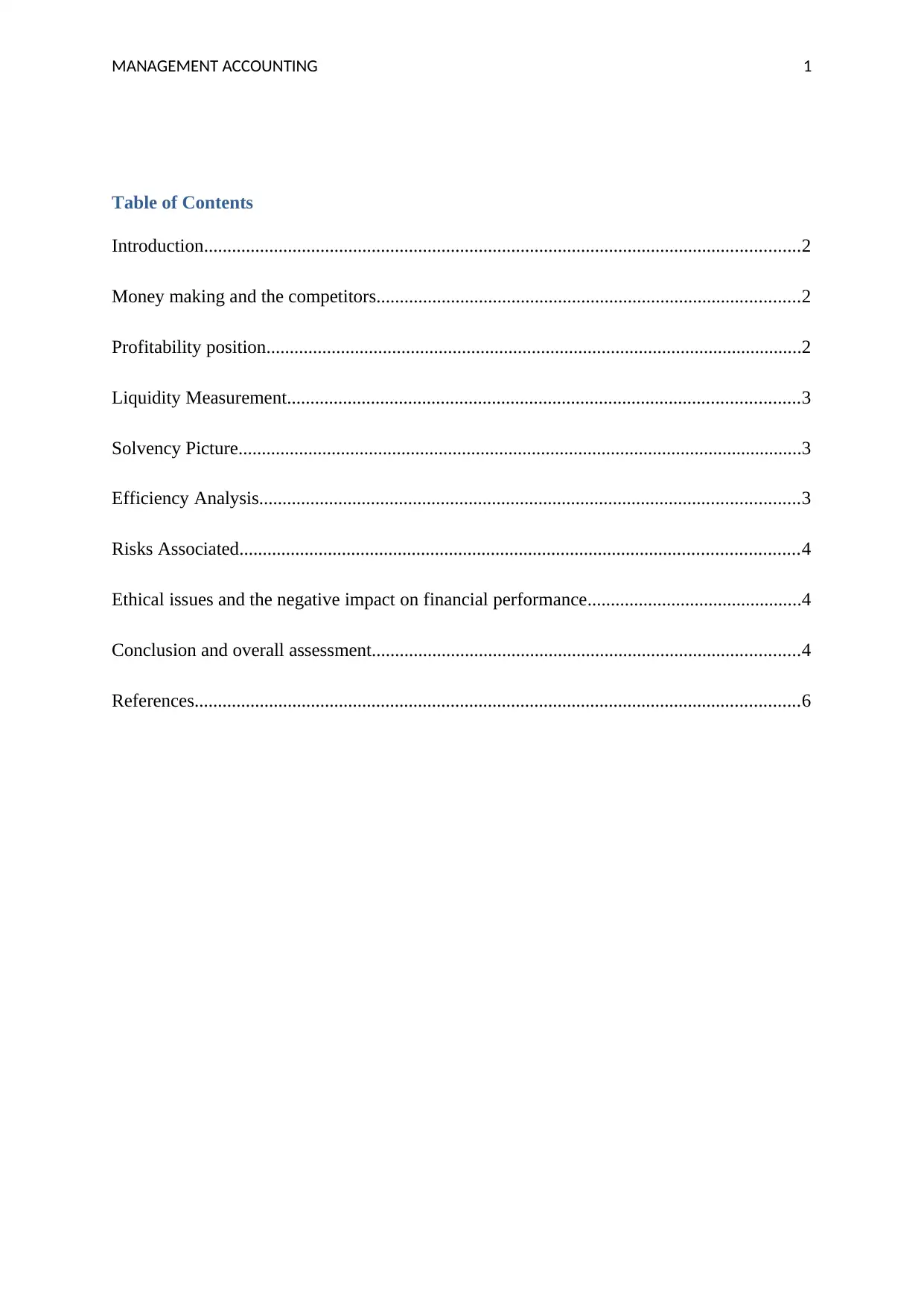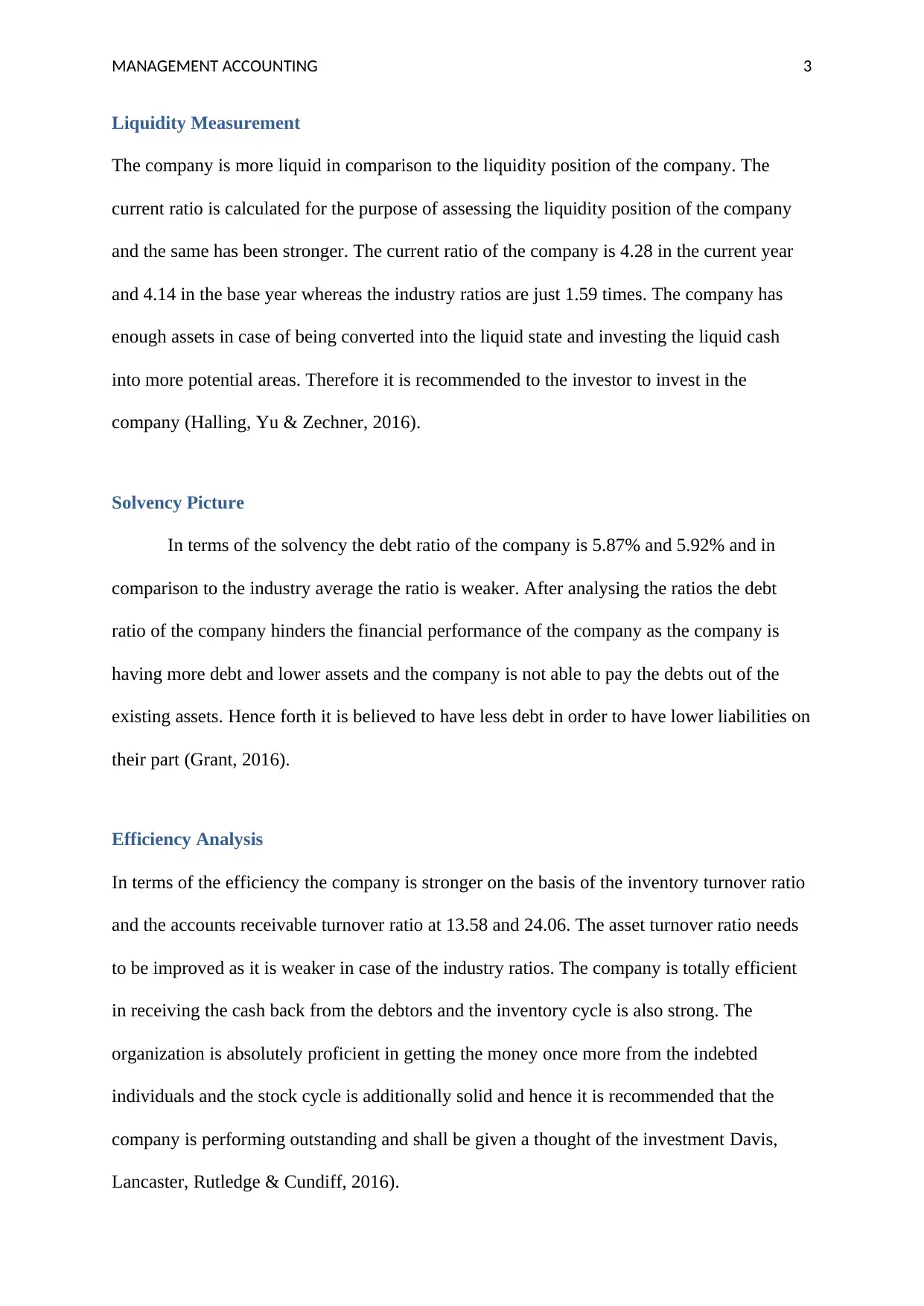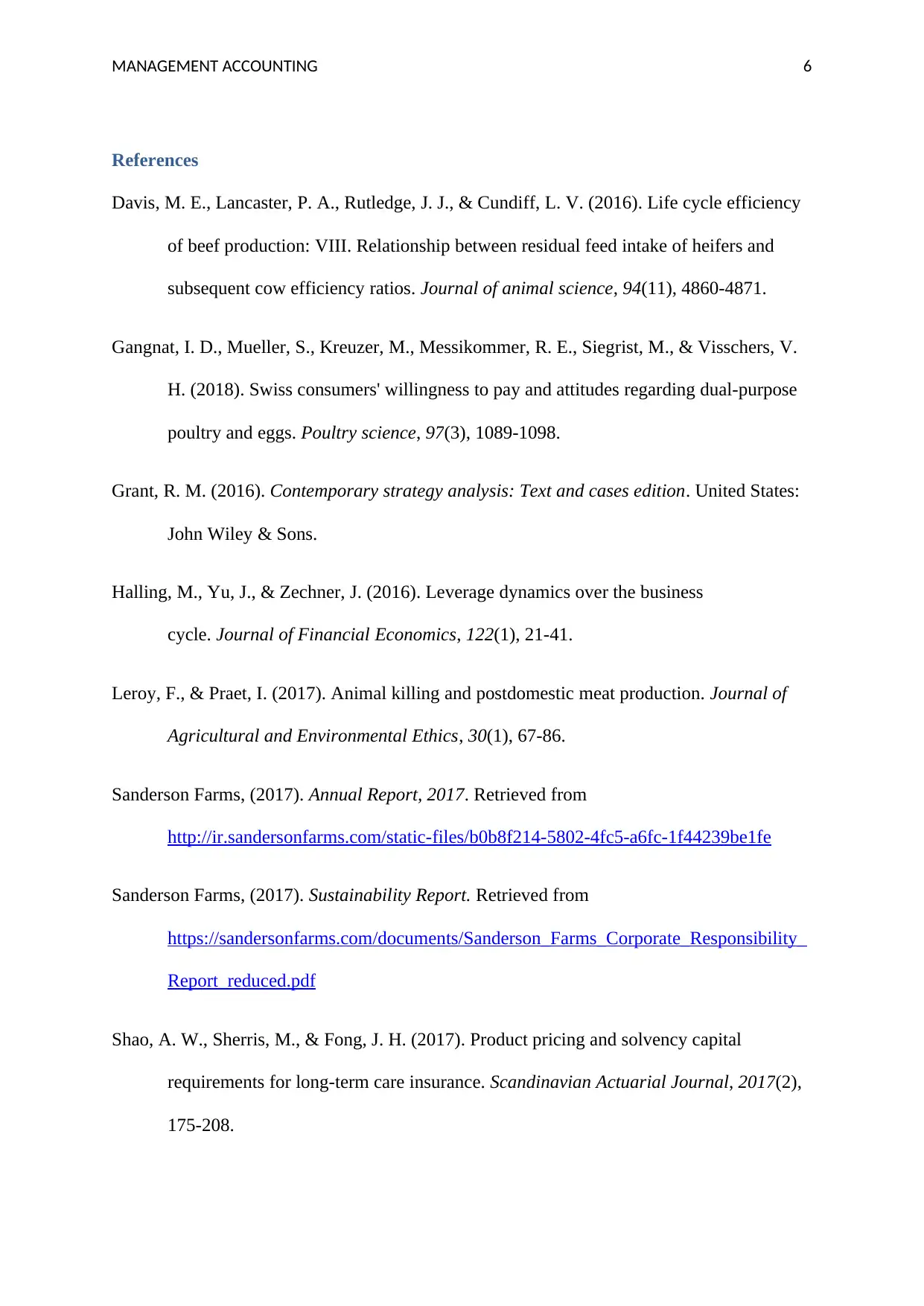Financial Statement Analysis of Sanderson Farms - BACC2103 Project
VerifiedAdded on 2023/06/04
|7
|1454
|143
Report
AI Summary
This report provides a comprehensive financial analysis of Sanderson Farms, a US-based poultry producer, examining its profitability, liquidity, solvency, and efficiency. The analysis includes a comparison of the company's financial ratios with industry averages, highlighting strengths in liquidity and inventory turnover, while also pointing out weaknesses in debt ratio and asset turnover. The report also addresses risks associated with market dynamics, climate change, and ethical concerns related to animal welfare and antibiotic use, and concludes with an overall assessment of the company's financial health, recommending investment while acknowledging areas for improvement. The report was prepared as part of the BACC2103 Financial Accounting Project.

Running Head: MANAGEMENT ACCOUNTING 0
Management Accounting
Management Accounting
Paraphrase This Document
Need a fresh take? Get an instant paraphrase of this document with our AI Paraphraser

MANAGEMENT ACCOUNTING 1
Table of Contents
Introduction................................................................................................................................2
Money making and the competitors...........................................................................................2
Profitability position...................................................................................................................2
Liquidity Measurement..............................................................................................................3
Solvency Picture.........................................................................................................................3
Efficiency Analysis....................................................................................................................3
Risks Associated........................................................................................................................4
Ethical issues and the negative impact on financial performance..............................................4
Conclusion and overall assessment............................................................................................4
References..................................................................................................................................6
Table of Contents
Introduction................................................................................................................................2
Money making and the competitors...........................................................................................2
Profitability position...................................................................................................................2
Liquidity Measurement..............................................................................................................3
Solvency Picture.........................................................................................................................3
Efficiency Analysis....................................................................................................................3
Risks Associated........................................................................................................................4
Ethical issues and the negative impact on financial performance..............................................4
Conclusion and overall assessment............................................................................................4
References..................................................................................................................................6

MANAGEMENT ACCOUNTING 2
Introduction
Sanderson Farms is the US based company involved in the business of the poultry market and
produces 9.376 million chickens per week. It’s headquartered in Mississippi. The foundation
of the company happened in the year 1947. Sanderson Farms are the companies which
largely control the poultry farming industry in the United States (Sanderson Farms, 2017).
Money making and the competitors
Sanderson farms basically earn the money from the sale of the poultry products. The net sale
increased of the poultry products by 9.2%. The company is involved in the industry of
poultry products. The company sells the ice packs, chill packs, frozen chicken in whole and
the cut up and the boneless form. The competitors of the Sanderson Farms are Wayne farms,
Perdue and case farms. The company is different from the competitor in terms of the
company selling the merchandising needs which assists in adding the value of the product.
The handling, storage and distribution and marketing needs (Shao, Sherris & Fong, 2017).
Profitability position
The profit position of the company is sound and has increased in comparison to the
previous year. The profit has increased mainly due to increase in the net sales which thereby
helped in the in acceleration of the profit. The profit of the current year of the Sanderson
farms is $279745 and in comparison to the previous year which was $188961 and it increased
by 8.37% in comparison to the base year. When compared to the industry ratios the Net profit
ratio of the industry is 9.07% and it showcases the weakness of the company as the overall
prices of the poultry product increased. The main driver of the change is the competition and
the price barrier of the company (Shao, Sherris & Fong, 2017).
Introduction
Sanderson Farms is the US based company involved in the business of the poultry market and
produces 9.376 million chickens per week. It’s headquartered in Mississippi. The foundation
of the company happened in the year 1947. Sanderson Farms are the companies which
largely control the poultry farming industry in the United States (Sanderson Farms, 2017).
Money making and the competitors
Sanderson farms basically earn the money from the sale of the poultry products. The net sale
increased of the poultry products by 9.2%. The company is involved in the industry of
poultry products. The company sells the ice packs, chill packs, frozen chicken in whole and
the cut up and the boneless form. The competitors of the Sanderson Farms are Wayne farms,
Perdue and case farms. The company is different from the competitor in terms of the
company selling the merchandising needs which assists in adding the value of the product.
The handling, storage and distribution and marketing needs (Shao, Sherris & Fong, 2017).
Profitability position
The profit position of the company is sound and has increased in comparison to the
previous year. The profit has increased mainly due to increase in the net sales which thereby
helped in the in acceleration of the profit. The profit of the current year of the Sanderson
farms is $279745 and in comparison to the previous year which was $188961 and it increased
by 8.37% in comparison to the base year. When compared to the industry ratios the Net profit
ratio of the industry is 9.07% and it showcases the weakness of the company as the overall
prices of the poultry product increased. The main driver of the change is the competition and
the price barrier of the company (Shao, Sherris & Fong, 2017).
⊘ This is a preview!⊘
Do you want full access?
Subscribe today to unlock all pages.

Trusted by 1+ million students worldwide

MANAGEMENT ACCOUNTING 3
Liquidity Measurement
The company is more liquid in comparison to the liquidity position of the company. The
current ratio is calculated for the purpose of assessing the liquidity position of the company
and the same has been stronger. The current ratio of the company is 4.28 in the current year
and 4.14 in the base year whereas the industry ratios are just 1.59 times. The company has
enough assets in case of being converted into the liquid state and investing the liquid cash
into more potential areas. Therefore it is recommended to the investor to invest in the
company (Halling, Yu & Zechner, 2016).
Solvency Picture
In terms of the solvency the debt ratio of the company is 5.87% and 5.92% and in
comparison to the industry average the ratio is weaker. After analysing the ratios the debt
ratio of the company hinders the financial performance of the company as the company is
having more debt and lower assets and the company is not able to pay the debts out of the
existing assets. Hence forth it is believed to have less debt in order to have lower liabilities on
their part (Grant, 2016).
Efficiency Analysis
In terms of the efficiency the company is stronger on the basis of the inventory turnover ratio
and the accounts receivable turnover ratio at 13.58 and 24.06. The asset turnover ratio needs
to be improved as it is weaker in case of the industry ratios. The company is totally efficient
in receiving the cash back from the debtors and the inventory cycle is also strong. The
organization is absolutely proficient in getting the money once more from the indebted
individuals and the stock cycle is additionally solid and hence it is recommended that the
company is performing outstanding and shall be given a thought of the investment Davis,
Lancaster, Rutledge & Cundiff, 2016).
Liquidity Measurement
The company is more liquid in comparison to the liquidity position of the company. The
current ratio is calculated for the purpose of assessing the liquidity position of the company
and the same has been stronger. The current ratio of the company is 4.28 in the current year
and 4.14 in the base year whereas the industry ratios are just 1.59 times. The company has
enough assets in case of being converted into the liquid state and investing the liquid cash
into more potential areas. Therefore it is recommended to the investor to invest in the
company (Halling, Yu & Zechner, 2016).
Solvency Picture
In terms of the solvency the debt ratio of the company is 5.87% and 5.92% and in
comparison to the industry average the ratio is weaker. After analysing the ratios the debt
ratio of the company hinders the financial performance of the company as the company is
having more debt and lower assets and the company is not able to pay the debts out of the
existing assets. Hence forth it is believed to have less debt in order to have lower liabilities on
their part (Grant, 2016).
Efficiency Analysis
In terms of the efficiency the company is stronger on the basis of the inventory turnover ratio
and the accounts receivable turnover ratio at 13.58 and 24.06. The asset turnover ratio needs
to be improved as it is weaker in case of the industry ratios. The company is totally efficient
in receiving the cash back from the debtors and the inventory cycle is also strong. The
organization is absolutely proficient in getting the money once more from the indebted
individuals and the stock cycle is additionally solid and hence it is recommended that the
company is performing outstanding and shall be given a thought of the investment Davis,
Lancaster, Rutledge & Cundiff, 2016).
Paraphrase This Document
Need a fresh take? Get an instant paraphrase of this document with our AI Paraphraser

MANAGEMENT ACCOUNTING 4
Risks Associated
There are several risks among which the major one is when the profitability is getting
affected by the dynamic prices in the market and are dependent upon the supply and demand
factors. As a result the poultry industry is subjected to the fluctuations in the prices. In
particular the factors such as the global warming and the weather conditions resulting from
the change in the climate also affect the company and increase the risk (Leroy & Praet, 2017).
Apart for that the other risks faced by the company are the increase in the cost of the material.
The general and the economic and the competitive changes are also the factors that impose
the risk factors (Gangnat, 2018).
Ethical issues and the negative impact on financial performance
The one ethical issue that is being suffered by the company and the most important one is the
obligation if the well beings of the poultry animals. The animals are given the antibiotics so
that while producing the poultry products to the customers the risk of the disease can be
lowered down. Moreover the environment of the animals is not healthy and this is the biggest
challenge of the company. The negative risks associated with this issue is majorly the loss of
the brand value of the company and the effect of the negative image created due to the foul
products produced to the customers which may create heath issues. This issue basically
impacts the financial position of the business by lowering down the volume of sales and the
reduced stock price that creates the lower revenue for the company (Sanderson Farms, 2017).
Conclusion and overall assessment
From the overall assessment the company is performing sound and healthy and still
have some scope for the improvement. Moreover in comparison to its competitors and the
industry ratios the company is stronger in 5 areas. Apart for this the company has also
improved the sales pattern and the way the company is handling the customer service of the
Risks Associated
There are several risks among which the major one is when the profitability is getting
affected by the dynamic prices in the market and are dependent upon the supply and demand
factors. As a result the poultry industry is subjected to the fluctuations in the prices. In
particular the factors such as the global warming and the weather conditions resulting from
the change in the climate also affect the company and increase the risk (Leroy & Praet, 2017).
Apart for that the other risks faced by the company are the increase in the cost of the material.
The general and the economic and the competitive changes are also the factors that impose
the risk factors (Gangnat, 2018).
Ethical issues and the negative impact on financial performance
The one ethical issue that is being suffered by the company and the most important one is the
obligation if the well beings of the poultry animals. The animals are given the antibiotics so
that while producing the poultry products to the customers the risk of the disease can be
lowered down. Moreover the environment of the animals is not healthy and this is the biggest
challenge of the company. The negative risks associated with this issue is majorly the loss of
the brand value of the company and the effect of the negative image created due to the foul
products produced to the customers which may create heath issues. This issue basically
impacts the financial position of the business by lowering down the volume of sales and the
reduced stock price that creates the lower revenue for the company (Sanderson Farms, 2017).
Conclusion and overall assessment
From the overall assessment the company is performing sound and healthy and still
have some scope for the improvement. Moreover in comparison to its competitors and the
industry ratios the company is stronger in 5 areas. Apart for this the company has also
improved the sales pattern and the way the company is handling the customer service of the

MANAGEMENT ACCOUNTING 5
company. Moreover the company is in the working with the motive of the good honest
chicken. Apart from this the P/E ratio of the Sanderson Farms is 13.29 which determine the
price per EPS given to the shareholders of the company. Therefore it is recommended to the
investors and the clients to invest in the company and hold the stock for a long term until they
get the better prices.
company. Moreover the company is in the working with the motive of the good honest
chicken. Apart from this the P/E ratio of the Sanderson Farms is 13.29 which determine the
price per EPS given to the shareholders of the company. Therefore it is recommended to the
investors and the clients to invest in the company and hold the stock for a long term until they
get the better prices.
⊘ This is a preview!⊘
Do you want full access?
Subscribe today to unlock all pages.

Trusted by 1+ million students worldwide

MANAGEMENT ACCOUNTING 6
References
Davis, M. E., Lancaster, P. A., Rutledge, J. J., & Cundiff, L. V. (2016). Life cycle efficiency
of beef production: VIII. Relationship between residual feed intake of heifers and
subsequent cow efficiency ratios. Journal of animal science, 94(11), 4860-4871.
Gangnat, I. D., Mueller, S., Kreuzer, M., Messikommer, R. E., Siegrist, M., & Visschers, V.
H. (2018). Swiss consumers' willingness to pay and attitudes regarding dual-purpose
poultry and eggs. Poultry science, 97(3), 1089-1098.
Grant, R. M. (2016). Contemporary strategy analysis: Text and cases edition. United States:
John Wiley & Sons.
Halling, M., Yu, J., & Zechner, J. (2016). Leverage dynamics over the business
cycle. Journal of Financial Economics, 122(1), 21-41.
Leroy, F., & Praet, I. (2017). Animal killing and postdomestic meat production. Journal of
Agricultural and Environmental Ethics, 30(1), 67-86.
Sanderson Farms, (2017). Annual Report, 2017. Retrieved from
http://ir.sandersonfarms.com/static-files/b0b8f214-5802-4fc5-a6fc-1f44239be1fe
Sanderson Farms, (2017). Sustainability Report. Retrieved from
https://sandersonfarms.com/documents/Sanderson_Farms_Corporate_Responsibility_
Report_reduced.pdf
Shao, A. W., Sherris, M., & Fong, J. H. (2017). Product pricing and solvency capital
requirements for long-term care insurance. Scandinavian Actuarial Journal, 2017(2),
175-208.
References
Davis, M. E., Lancaster, P. A., Rutledge, J. J., & Cundiff, L. V. (2016). Life cycle efficiency
of beef production: VIII. Relationship between residual feed intake of heifers and
subsequent cow efficiency ratios. Journal of animal science, 94(11), 4860-4871.
Gangnat, I. D., Mueller, S., Kreuzer, M., Messikommer, R. E., Siegrist, M., & Visschers, V.
H. (2018). Swiss consumers' willingness to pay and attitudes regarding dual-purpose
poultry and eggs. Poultry science, 97(3), 1089-1098.
Grant, R. M. (2016). Contemporary strategy analysis: Text and cases edition. United States:
John Wiley & Sons.
Halling, M., Yu, J., & Zechner, J. (2016). Leverage dynamics over the business
cycle. Journal of Financial Economics, 122(1), 21-41.
Leroy, F., & Praet, I. (2017). Animal killing and postdomestic meat production. Journal of
Agricultural and Environmental Ethics, 30(1), 67-86.
Sanderson Farms, (2017). Annual Report, 2017. Retrieved from
http://ir.sandersonfarms.com/static-files/b0b8f214-5802-4fc5-a6fc-1f44239be1fe
Sanderson Farms, (2017). Sustainability Report. Retrieved from
https://sandersonfarms.com/documents/Sanderson_Farms_Corporate_Responsibility_
Report_reduced.pdf
Shao, A. W., Sherris, M., & Fong, J. H. (2017). Product pricing and solvency capital
requirements for long-term care insurance. Scandinavian Actuarial Journal, 2017(2),
175-208.
1 out of 7
Related Documents
Your All-in-One AI-Powered Toolkit for Academic Success.
+13062052269
info@desklib.com
Available 24*7 on WhatsApp / Email
![[object Object]](/_next/static/media/star-bottom.7253800d.svg)
Unlock your academic potential
Copyright © 2020–2025 A2Z Services. All Rights Reserved. Developed and managed by ZUCOL.



